Mangrove Ecosystem Services, Associated Threats and Implications for Wellbeing in the Mono Transboundary Biosphere Reserve (Togo-Benin), West-Africa
Abstract
:1. Introduction
- (a)
- What are the perceived ecosystem services provided by mangroves to local communities in the MTBR?
- (b)
- What are the most important services in the reserve?
- (c)
- Are local residents satisfied with the extent to which the current supply of mangrove ES sustains their wellbeing and livelihoods in the reserve?
- (d)
- What are the threats to mangrove ES in the MTBR and how are they spatially distributed?
- (e)
- Are mangrove ES and their associated threats similar between the two countries which share the MTBR?
2. Materials and Methods
2.1. Study Area
2.2. Study Design and Data Collection Procedures
2.2.1. Field Reconnaissance
2.2.2. Focus Groups Discussion
2.2.3. In-Depth Interviews
2.2.4. Field Observations
2.2.5. Quantitative Household Survey
2.2.6. Participatory Mapping of the Major Threats
2.2.7. Ethical Considerations
2.3. Data Analysis
2.3.1. Qualitative Data
2.3.2. Quantitative Data
3. Results
3.1. Perceived Mangrove Ecosystem Services in the MTBR
3.2. The Most Provided Mangrove Ecosystem Services in the MTBR
3.3. Mangrove Ecosystem Services and Its Effects on Wellbeing and Livelihoods of Local Communities in the MTBR
3.4. Threats to Mangrove Ecosystem Services in the Reserve
4. Discussion
4.1. Diversity of Mangrove ES in the MTBR
4.2. Predominance of Mangrove ES in the MTBR
4.3. Mangrove ES Sustaining Peoples’ Livelihood and Wellbeing in the MTBR
4.4. Major Threats to Mangrove ES in the MTBR
4.5. Implications for Management Policies
5. Conclusions
Supplementary Materials
Author Contributions
Funding
Institutional Review Board Statement
Informed Consent Statement
Data Availability Statement
Acknowledgments
Conflicts of Interest
References
- Luo, Y.Y.; Not, C.; Cannicci, S. Mangroves as unique but understudied traps for anthropogenic marine debris: A review of present information and the way forward. Environ. Pollut. 2021, 271, 116291. [Google Scholar] [CrossRef]
- Hatje, V.; Masqué, P.; Patire, V.F.; Dórea, A.; Barros, F. Blue carbon stocks, accumulation rates, and associated spatial variability in Brazilian mangroves. Limnol. Oceanogr. 2021, 66, 321–334. [Google Scholar] [CrossRef]
- Boateng, I. An assessment of vulnerability and adaptation of coastal mangroves of West Africa in the face of climate change. In Threats to Mangrove Forests; Springer: Cham, Switzerland, 2018; pp. 141–154. [Google Scholar] [CrossRef]
- Turner, M.D.; Ayantunde, A.A.; Patterson, K.P.; Patterson, E.D., III. Livelihood transitions and the changing nature of farmer–herder conflict in Sahelian West Africa. J. Dev. Stud. 2011, 47, 183–206. [Google Scholar] [CrossRef]
- Aheto, D.W.; Kankam, S.; Okyere, I.; Mensah, E.; Osman, A.; Jonah, F.E.; Mensah, J.C. Community-based mangrove forest management: Implications for local livelihoods and coastal resource conservation along the Volta estuary catchment area of Ghana. Ocean. Coast. Manag. 2016, 127, 43–54. [Google Scholar] [CrossRef]
- Padonou, E.A.; Gbaï, N.I.; Kolawolé, M.A.; Idohou, R.; Toyi, M. How far are mangrove ecosystems in Benin (West Africa) conserved by the Ramsar Convention? Land Use Policy 2021, 108, 105583. [Google Scholar] [CrossRef]
- Adjonou, K.; Bindaoudou, I.A.K.; Segla, K.N.; Idohou, R.; Salako, K.V.; Glele-Kakaï, R.; Kokou, K. Land use/land cover patterns and challenges to sustainable management of the Mono transboundary biosphere reserve between Togo and Benin, West Africa. Int. J. Biol. Chem. Sci. 2020, 14, 1734–1751. [Google Scholar] [CrossRef]
- Ghaley, B.B.; Vesterdal, L.; Porter, J.R. Quantification and valuation of ecosystem services in diverse production systems for informed decision-making. Environ. Sci. Policy 2014, 39, 139–149. [Google Scholar] [CrossRef]
- Jiang, C.; Li, D.; Wang, D.; Zhang, L. Quantification and assessment of changes in ecosystem service in the Three-River Headwaters Region, China as a result of climate variability and land cover change. Ecol. Indic. 2016, 66, 199–211. [Google Scholar] [CrossRef]
- Sharma, S.; MacKenzie, R.A.; Tieng, T.; Soben, K.; Tulyasuwan, N.; Resanond, A.; Blate, G.; Litton, C.M. The impacts of degradation, deforestation and restoration on mangrove ecosystem carbon stocks across Cambodia. Sci. Total Environ. 2020, 706, 135416. [Google Scholar] [CrossRef]
- Gnansounou, S.C.; Toyi, M.; Salako, K.V.; Ahossou, D.O.; Akpona, T.J.D.; Gbedomon, R.C.; Kakaï, R.G. Local uses of mangroves and perceived impacts of their degradation in Grand-Popo municipality, a hotspot of mangroves in Benin, West Africa. Trees For. People 2021, 4, 100080. [Google Scholar] [CrossRef]
- Teka, O.; Houessou, L.G.; Djossa, B.A.; Bachmann, Y.; Oumorou, M.; Sinsin, B. Mangroves in Benin, West Africa: Threats, uses and conservation opportunities. Environ. Dev. Sustain. 2019, 21, 1153–1169. [Google Scholar] [CrossRef]
- Adanguidi, J.; Padonou, E.A.; Zannou, A.; Houngbo, S.B.; Saliou, I.O.; Agbahoungba, S. Fuelwood consumption and supply strategies in mangrove forests-Insights from RAMSAR sites in Benin. For. Policy Econ. 2020, 2020, 102192. [Google Scholar] [CrossRef]
- Zanvo, M.S.; Salako, K.V.; Gnanglè, C.; Mensah, S.; Assogbadjo, A.E.; Kakaï, R.G. Impacts of harvesting intensity on tree taxonomic diversity, structural diversity, population structure, and stability in a West African mangrove forest. Wetl. Ecol. Manag. 2021, 29, 433–450. [Google Scholar] [CrossRef]
- Ajonina, G.N.; Kairo, J.; Grimsditch, G.; Sembres, T.; Chuyong, G.; Diyouke, E. Assessment of mangrove carbon stocks in Cameroon, Gabon, the Republic of Congo (RoC) and the Democratic Republic of Congo (DRC) including their potential for reducing emissions from deforestation and forest degradation (REDD+). In The Land/Ocean Interactions in the Coastal Zone of West and Central Africa; Springer: Cham, Switzerland, 2014; pp. 177–189. [Google Scholar] [CrossRef]
- Reyes-Arroyo, N.; Camacho-Valdez, V.; Saenz-Arroyo, A.; Infante-Mata, D. Socio-cultural analysis of ecosystem services provided by mangroves in La Encrucijada Biosphere Reserve, southeastern Mexico. Local Environ. 2021, 26, 86–109. [Google Scholar] [CrossRef]
- MEA. Ecosystems and Human Well-Being. 2010. Available online: http://www.alexandrina.org/CSSP/Event/Material/MEA_businessesdocument.353.aspx.pdf (accessed on 7 September 2021).
- Hák, T.; Janoušková, S.; Moldan, B. Sustainable Development Goals: A need for relevant indicators. Ecol. Indic. 2016, 60, 565–573. [Google Scholar] [CrossRef]
- Johnson, R.B.; Onwuegbuzie, A.J. Mixed methods research: A research paradigm whose time has come. Educ. Res. 2004, 33, 14–26. [Google Scholar] [CrossRef] [Green Version]
- Freduah, G.; Fidelman, P.; Smith, T.F. The impacts of environmental and socio-economic stressors on small scale fisheries and livelihoods of fishers in Ghana. Appl. Geogr. 2017, 89, 1–11. [Google Scholar] [CrossRef]
- Etikan, I.; Musa, S.A.; Alkassim, R.S. Comparison of convenience sampling and purposive sampling. Am. J. Theor. Appl. Stat. 2016, 5, 1–4. [Google Scholar] [CrossRef] [Green Version]
- Sagoe, A.A.; Aheto, D.W.; Okyere, I.; Adade, R.; Odoi, J. Community participation in assessment of fisheries related ecosystem services towards the establishment of marine protected area in the Greater Cape Three Points area in Ghana. Mar. Policy 2021, 124, 104336. [Google Scholar] [CrossRef]
- Kusakari, Y.; Asubonteng, K.O.; Jasaw, G.S.; Dayour, F.; Dzivenu, T.; Lolig, V.; Donkoh, S.A.; Obeng, F.K.; Gandaa, B.; Kranjac-Berisavljevic, G. Farmer-perceived effects of climate change on livelihoods in Wa West District, Upper West Region of Ghana. J. Disaster Res. 2014, 9, 516–528. [Google Scholar] [CrossRef]
- Mensah, S.; Veldtman, R.; Assogbadjo, A.E.; Ham, C.; Kakaï, R.G.; Seifert, T. Ecosystem service importance and use vary with socio-environmental factors: A study from household-surveys in local communities of South Africa. Ecosyst. Serv. 2017, 23, 1–8. [Google Scholar] [CrossRef]
- Köhl, M.; Magnussen, S.; Marchetti, M. Sampling Methods, Remote Sensing and GIS Multiresource Forest Inventory; Springer: Berlin/Heidelberg, Germany, 2006. [Google Scholar] [CrossRef]
- Guelly, K.; Hodabalo, P.; Oyétoundé, D. Des Acteurs et des Ecosystèmes de Mangrove du Littoral Togolais. 2020. Available online: http://www.fao.org/3/ca8640fr/CA8640FR.pdf (accessed on 3 June 2021).
- Ecobenin. ACCB-Bouche du Roy: Plan D’aménagement et de Gesti on Simplifi é (2017–2021). Available online: http://docplayer.fr/72316358-Accb-bouche-du-roy-plan-d-amenagement-et-de-gestion-simplifie.html (accessed on 9 June 2021).
- Haines-Young, R.; Potschin, M. Common International Classification of Ecosystem Services (CICES) V5. 1. Guidance on the Application of the Revised Structure. 2017. Available online: file:///C:/Users/Constant%20Gnansounou/Downloads/OE_article_27108.pdf (accessed on 23 September 2021).
- Core Team R. A language and Environment For Statistical Computing. R Foundation for Statistical Computing, Vienna, Austria. 2021. Available online: http://www.r-project.org/index.html (accessed on 3 June 2021).
- Bosquet, C.; Boulhol, H. Applying the GLM variance assumption to overcome the scale-dependence of the negative binomial QGPML estimator. Econom. Rev. 2014, 33, 772–784. [Google Scholar] [CrossRef]
- Nyangoko, B.P.; Berg, H.; Mangora, M.M.; Gullström, M.; Shalli, M.S. Community perceptions of mangrove ecosystem services and their determinants in the Rufiji Delta, Tanzania. Sustainability 2021, 13, 63. [Google Scholar] [CrossRef]
- Owuor, M.A.; Icely, J.; Newton, A. Community perceptions of the status and threats facing mangroves of Mida Creek, Kenya: Implications for community-based management. Ocean Coast. Manag. 2019, 175, 172–179. [Google Scholar] [CrossRef]
- Vaughn, S.E. Disappearing mangroves: The epistemic politics of climate adaptation in Guyana. Cult. Anthropol. 2017, 32, 242–268. Available online: https://journal.culanth.org/index.php/ca/article/view/ca32.2.07 (accessed on 3 June 2021). [CrossRef] [Green Version]
- Fousseni, F.; Andrianamenoso, R.; Kperkouma, W.; Agbelessessi, W.; Madjouma, K.; Hodabalo, P.; Koffi, A. Écologie et dynamique spatio-temporelle des mangroves au Togo. VertigO Rev. Électronique Sci. L’environnement 2017, 17. Available online: https://id.erudit.org/iderudit/1058386ar (accessed on 4 June 2021). [CrossRef]
- Okyere, I.; Chuku, E.O.; Ekumah, B.; Angnuureng, D.B.; Boakye-Appiah, J.K.; Mills, D.J.; Babanawo, R.; Asare, N.K.; Aheto, D.W.; Crawford, B. Physical distancing and risk of COVID-19 in small-scale fisheries: A remote sensing assessment in coastal Ghana. Sci. Rep. 2020, 10, 22407. [Google Scholar] [CrossRef]
- Adite, A.; Imorou Toko, I.; Gbankoto, A. Fish assemblages in the degraded mangrove ecosystems of the coastal zone, Benin, West Africa: Implications for ecosystem restoration and resources conservation. J. Environ. Prot. 2013, 2013, 41488. Available online: https://www.scirp.org/journal/PaperInformation.aspx?PaperID=41488 (accessed on 4 April 2021). [CrossRef] [Green Version]
- Daïnou, K.; Vermeulen, C.; Doucet, J.L. Consommation de bois en zones humides du complexe ouest du Bénin: Besoins et gestion locale des formations ligneuses. BOIS For. Des Trop. 2008, 298, 13–24. [Google Scholar] [CrossRef]
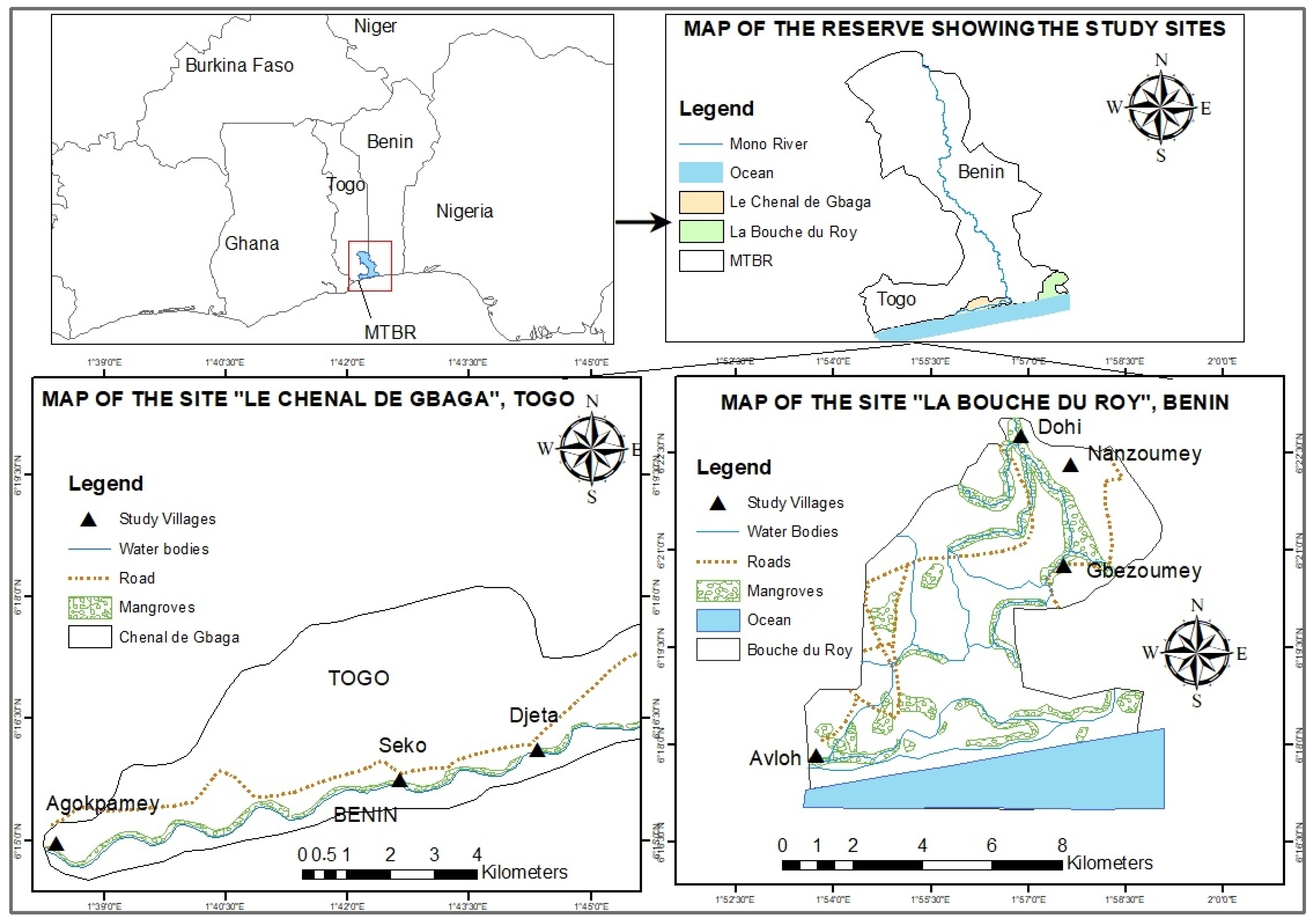
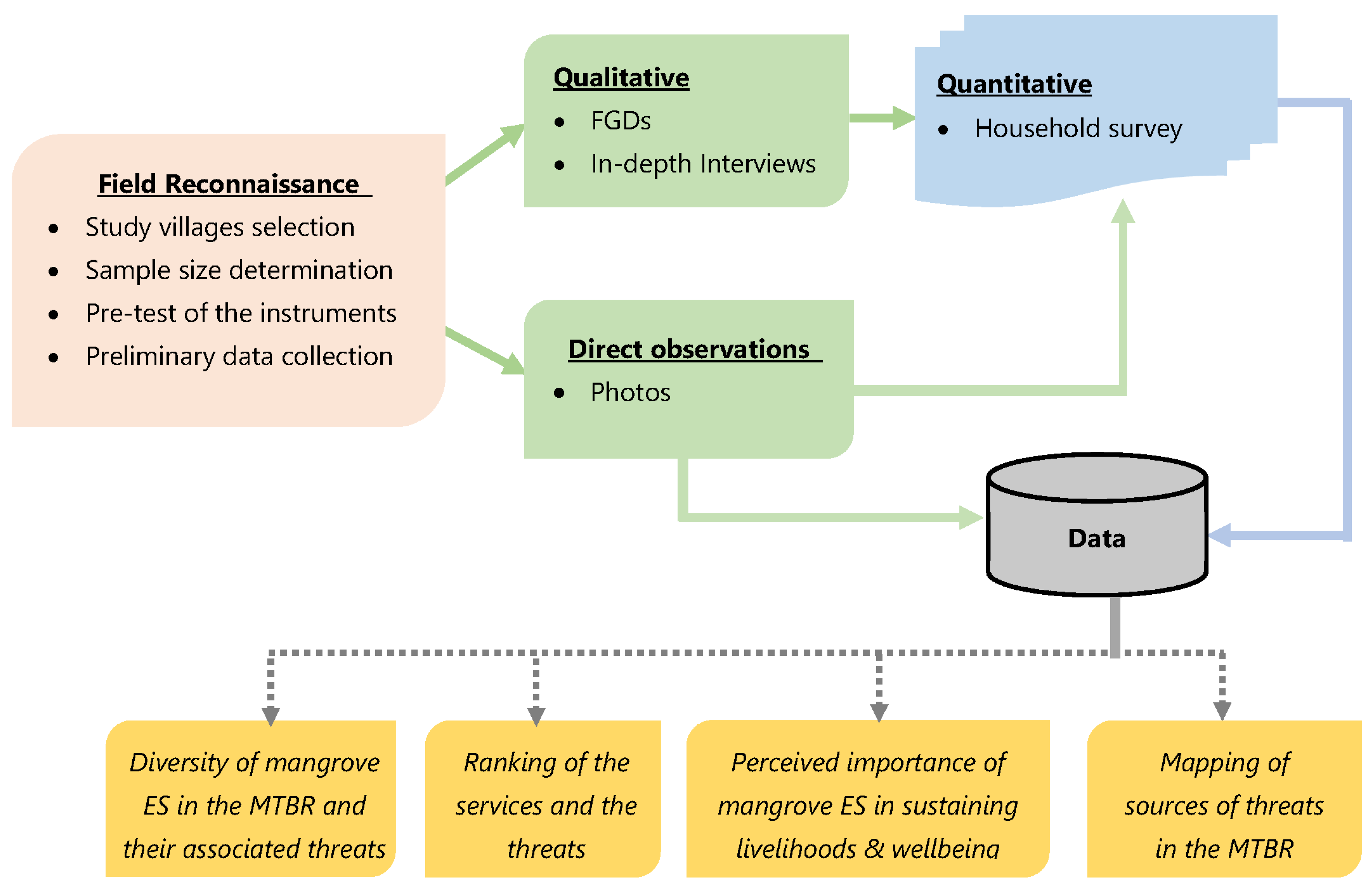
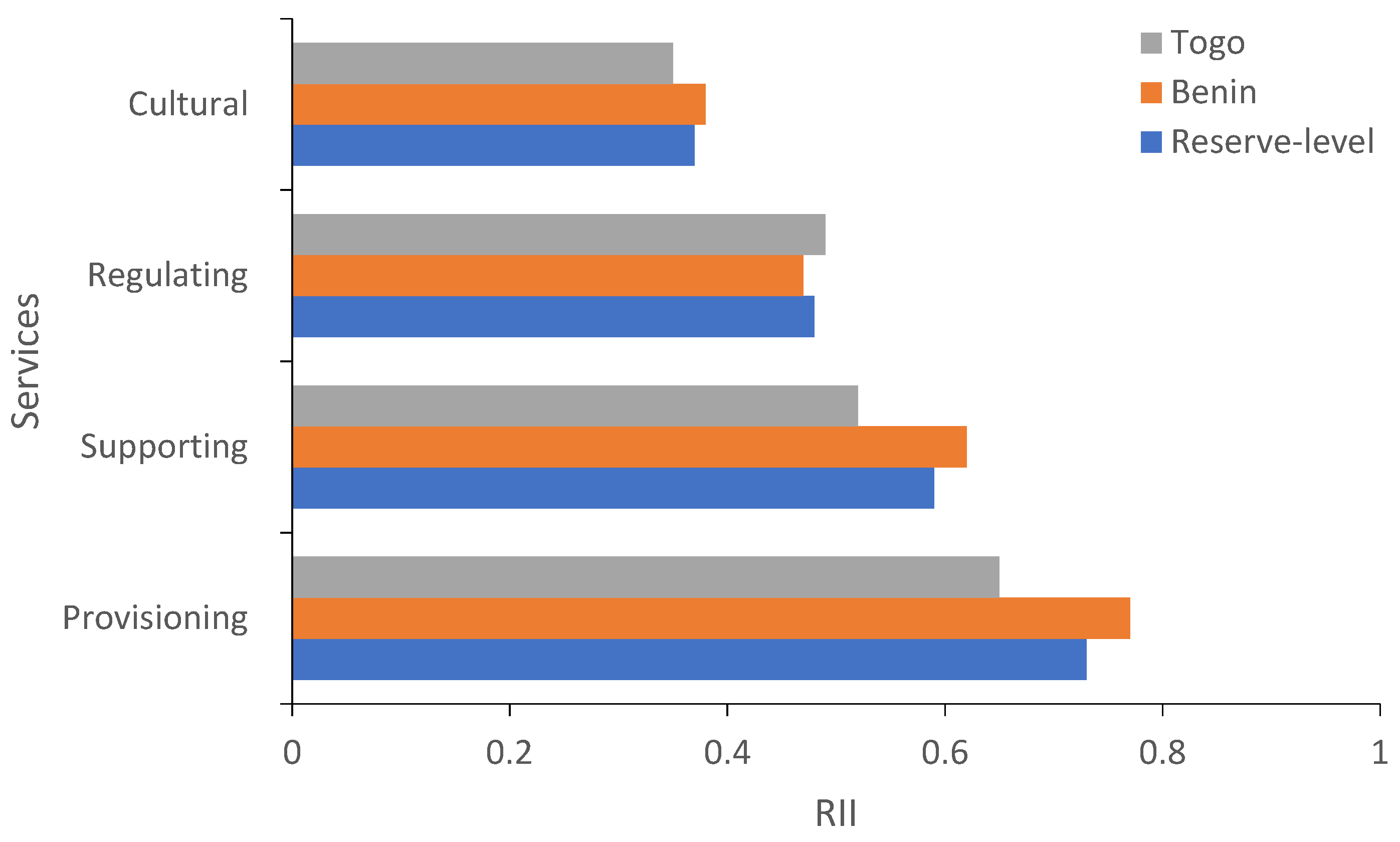
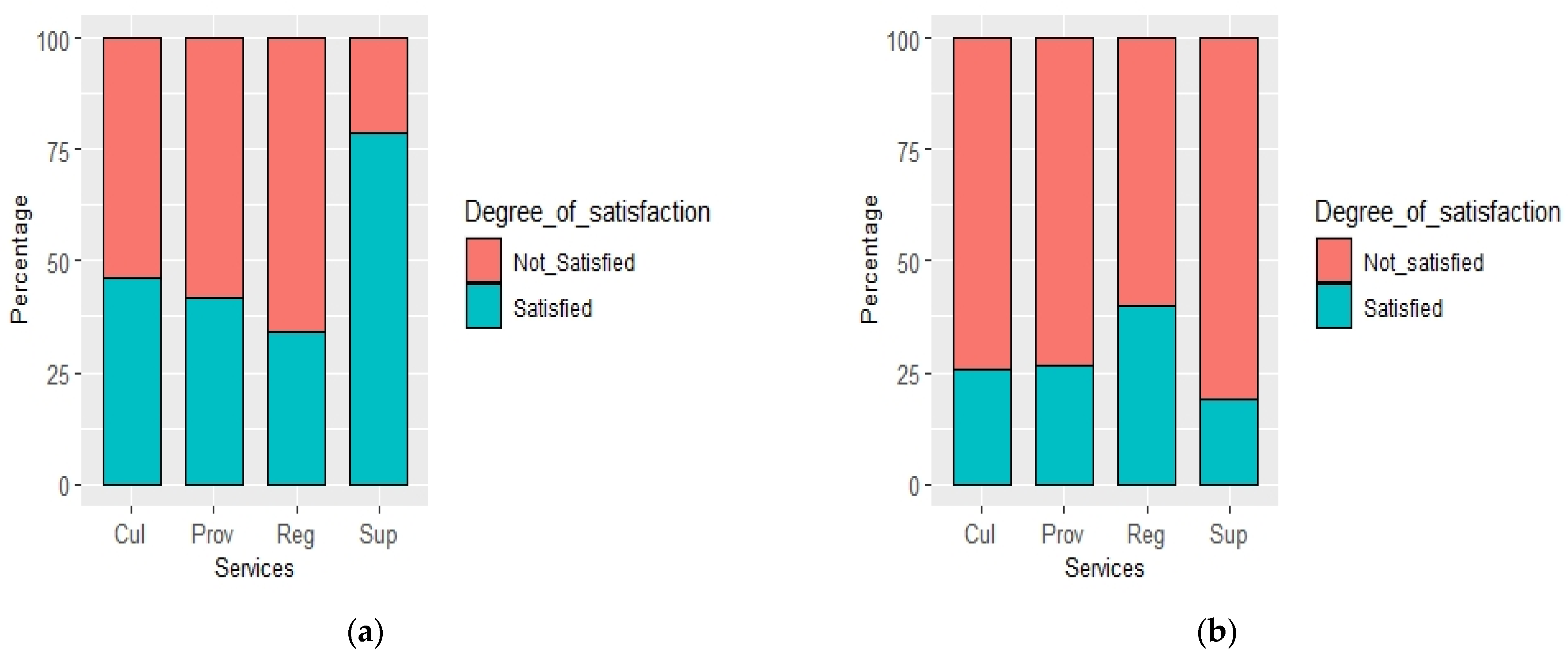
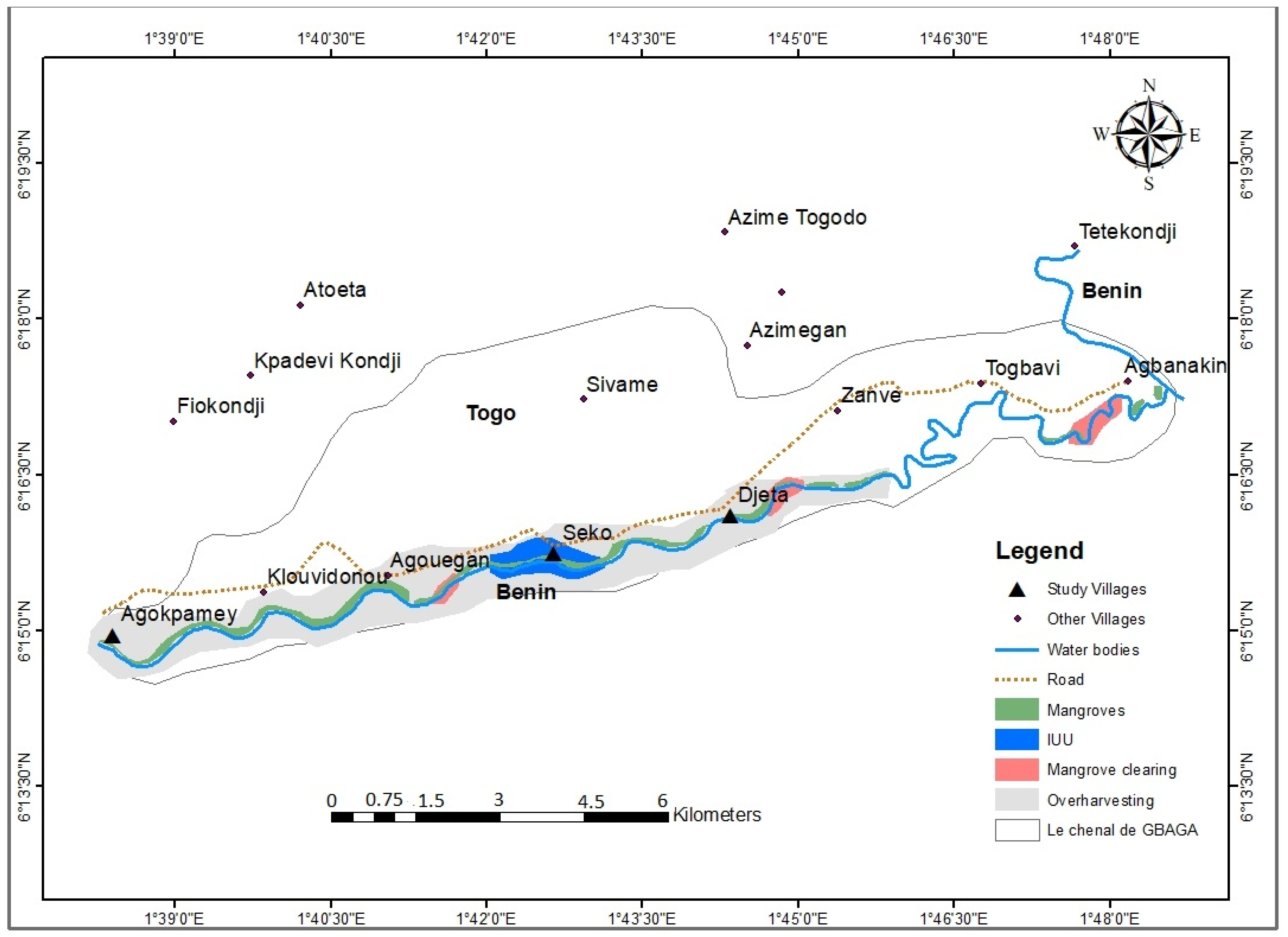
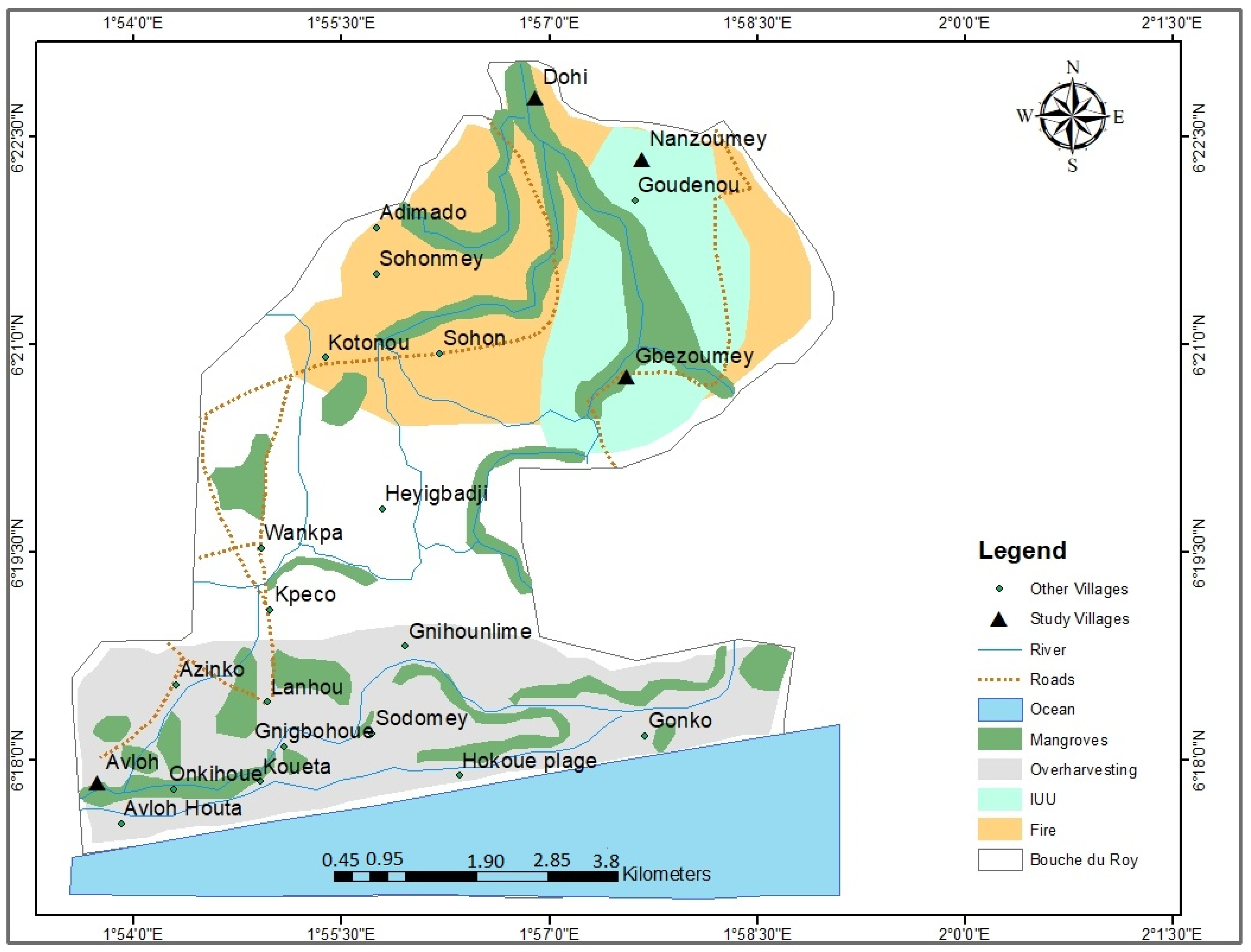
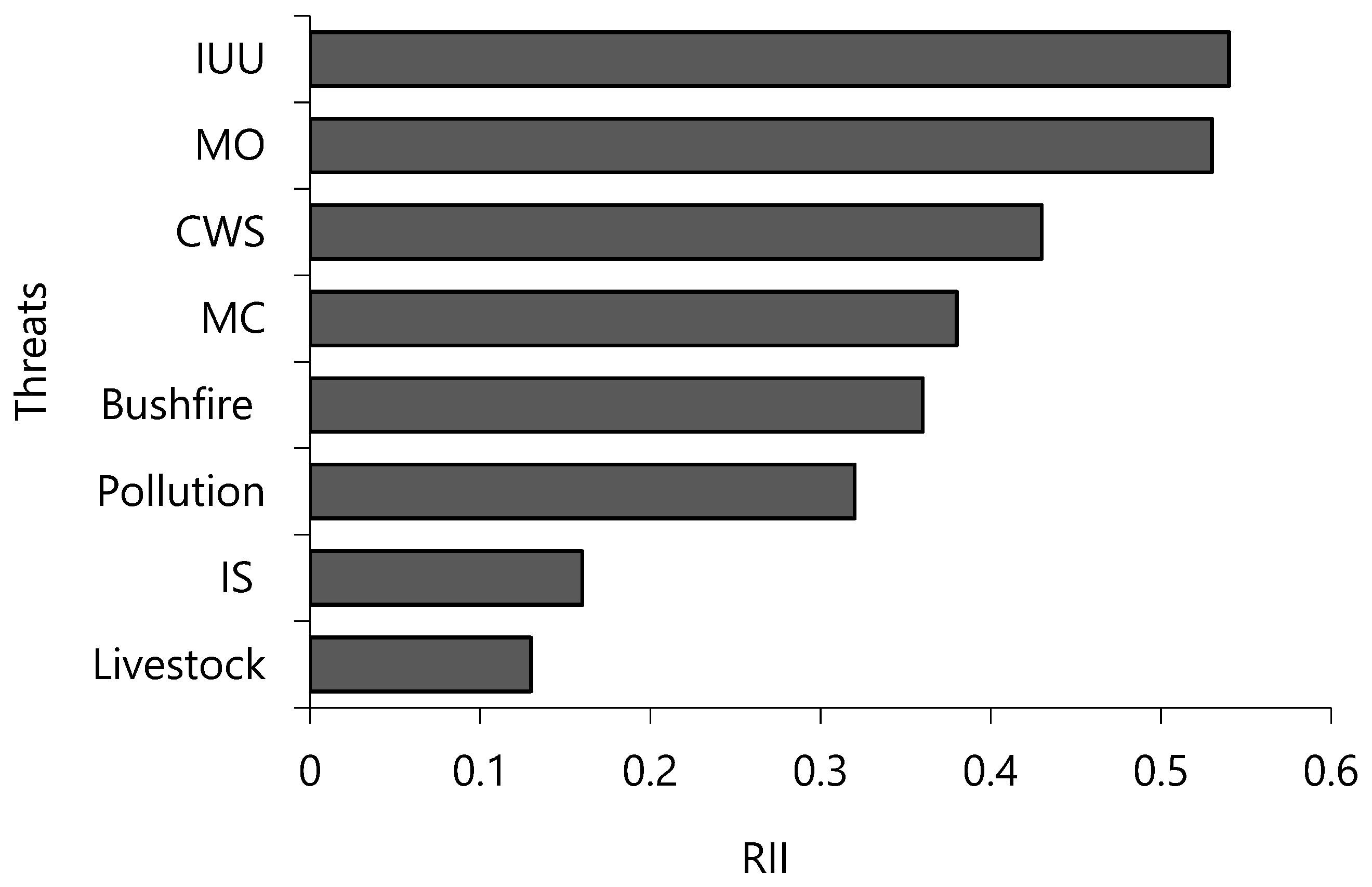
| Services | Country | Summary of Participants’ Narratives | ||
|---|---|---|---|---|
| Benin | Togo | |||
| Provisioning services | Provision of Fish | A * | A * |
|
| Provision of Crab | A * | A * |
| |
| Provision of Shrimp | A * | A * |
| |
| Provision of Oyster | A * | - |
| |
| Fodder | A * | B ** |
| |
| Non-Timber Forest Products | A * | - |
| |
| Timber | A *** | A * |
| |
| Firewood | A ** | A ** |
| |
| Water supply | B * | A * |
| |
| Regulating services | Climate Regulation | A * | A * |
|
| Erosion control | A *** | - |
| |
| Water purification | A *** | - |
| |
| Natural hazards control | B * | B * |
| |
| Supporting services | Spawning and Nursing grounds | A * | A ** |
|
| Biodiversity support | A * | A * |
| |
| Nutrient cycling | A * | A * |
| |
| Cultural services | Social relationships | B *** | - |
|
| Educational values | B * | B * |
| |
| Aesthetic values | A * | A *** |
| |
| Spiritual and religious values | B * | - |
| |
| Leisure, recreation and tourism | A * | A * |
| |
| Categories | Services | Benin | Togo | ||||
|---|---|---|---|---|---|---|---|
| Rank | TS | RII | Rank | TS | RII | ||
| Provisioning services | Fish provision | 1 | 724 | 0.78 | 1 | 333 | 0.74 |
| Timber collection | 2 | 588 | 0.63 | 5 | 201 | 0.44 | |
| Crab provision | 3 | 553 | 0.60 | 2 | 261 | 0.58 | |
| NTFPs | 4 | 524 | 0.56 | - | - | - | |
| Firewood collection | 5 | 471 | 0.51 | 3 | 226 | 0.50 | |
| Shrimp provision | 6 | 382 | 0.41 | 4 | 222 | 0.49 | |
| Water supply | 7 | 353 | 0.38 | 6 | 140 | 0.31 | |
| Fodder | 8 | 327 | 0.35 | 7 | 108 | 0.24 | |
| Oyster provision | 9 | 230 | 0.25 | - | - | - | |
| Regulating services | Climate regulation | 1 | 652 | 0.70 | 1 | 321 | 0.71 |
| Natural Hazards control | 2 | 448 | 0.48 | 2 | 226 | 0.50 | |
| Erosion control | 3 | 346 | 0.37 | - | - | - | |
| Water purification | 4 | 328 | 0.35 | - | - | - | |
| Supporting services | Biodiversity conservation | 1 | 695 | 0.75 | 1 | 303 | 0.67 |
| Nursing and spawning ground | 2 | 651 | 0.70 | 3 | 206 | 0.45 | |
| Nutrient cycling | 3 | 445 | 0.48 | 2 | 287 | 0.63 | |
| Cultural services | Educational values | 1 | 469 | 0.50 | 2 | 174 | 0.38 |
| Spiritual and religious values | 2 | 440 | 0.47 | - | - | - | |
| Aesthetic values | 3 | 395 | 0.42 | 1 | 186 | 0.41 | |
| Social relationship | 4 | 386 | 0.41 | - | - | - | |
| Tourism, recreation and leisure | 5 | 331 | 0.35 | 3 | 152 | 0.33 | |
| Factors | Provisioning | Supporting | Regulating | Cultural |
|---|---|---|---|---|
| Intercept | 1.60 (0.94) | 1.12 (1.12) | 0.58 (0.82) | 0.07 (0.90) |
| Young (Old as reference level) | ||||
| Adults | 0.22 (0.36) | 0.64 (1.21) | 0.19 (0.34) | −0.16 (0.37) |
| Old | 0.02 (0.38) | −0.14 (0.44) | −0.11 (0.36) | −0.68 (0.43) |
| Gender (Female as reference level) | ||||
| Male | −1.73 (0.38) *** | −0.25 (0.43) | −0.31 (0.34) | 0.11 (0.39 |
| Ethnical groups (Fon as reference level) | ||||
| Mina | −1.08 (0.87) | −0.97 (1.15) | −0.39 (0.76) | 0.06 (0,84) |
| Xwedah | 0.17 (0.66) | 0.43 (0.77) | −0.20 (0.57) | −0.73 (0.63) |
| Xwlah | 0.39 (0.69) | 0.37 (0.85) | −0.45 (0.63) | −0.34 (0.67) |
| Ouatchi | −0.13 (0.82) | −1.55 (1.13) | −0.81 (0.74) | −0.60 (0.80) |
| Ewe | −0.26 (0.82) | −0.93 (1.13) | −0.87 (0.75) | −3.24 (0.89) *** |
| Activity (Artisans as reference level) | ||||
| Fishermen | −0.28 (0.64) | −0.28 (0.80) | −1.25 (0.58) | −0.04 (0.65) |
| Mat weavers | −0.37 (0.45) | 0.84 (0.51) | −0.35 (0.41) | 0.97 (0.48) |
| Petty traders | −1.29 (0.74) | 1.73 (0.98) | −0.67 (0.73) | −0.29 (0.91) |
| Farmers | −0.70 (0.52) | 1.54 (0.63) | −0.38 (0.48) | 0.66 (0.56) |
| Salt producers | −1.62 (0.70) | −0.07 (0.73) | −1.42 (0.70) | −0.50 (0.77) |
| Education (Primary as reference level) | ||||
| Secondary | −0.02 (0.35) | 0.84 (0.44) | −0.02 (0.33) | 1.08 (0.38) ** |
| Uneducated | −0.81 (0.38) | −0.13 (0.44) | −0.05 (0.36) | 0.40 (0.43) |
| Country (Benin as reference level) | ||||
| Togo | −1.54 (0.58) ** | −4.09 (0.87) *** | −0.05 (0.51) | −1.54 (0.58) ** |
| Threats | Benin | Togo | ||||
|---|---|---|---|---|---|---|
| Rank | TS | RII | Rank | TS | RII | |
| Mangrove Overharvesting | 1 | 512 | 0.55 | 3 | 232 | 0.51 |
| Bushfire | 2 | 494 | 0.53 | - | - | - |
| IUU | 3 | 472 | 0.51 | 1 | 275 | 0.61 |
| Change in water salinity | 4 | 369 | 0.40 | 6 | 180 | 0.4 |
| Mangroves clearing | 5 | 308 | 0.33 | 2 | 236 | 0.52 |
| Pollution | 6 | 297 | 0.32 | 7 | 142 | 0.31 |
| Livestock | - | - | - | 4 | 218 | 0.48 |
| Invasive species | - | - | - | 5 | 224 | 0.49 |
Publisher’s Note: MDPI stays neutral with regard to jurisdictional claims in published maps and institutional affiliations. |
© 2022 by the authors. Licensee MDPI, Basel, Switzerland. This article is an open access article distributed under the terms and conditions of the Creative Commons Attribution (CC BY) license (https://creativecommons.org/licenses/by/4.0/).
Share and Cite
Gnansounou, S.C.; Salako, K.V.; Sagoe, A.A.; Mattah, P.A.D.; Aheto, D.W.; Glèlè Kakaï, R. Mangrove Ecosystem Services, Associated Threats and Implications for Wellbeing in the Mono Transboundary Biosphere Reserve (Togo-Benin), West-Africa. Sustainability 2022, 14, 2438. https://doi.org/10.3390/su14042438
Gnansounou SC, Salako KV, Sagoe AA, Mattah PAD, Aheto DW, Glèlè Kakaï R. Mangrove Ecosystem Services, Associated Threats and Implications for Wellbeing in the Mono Transboundary Biosphere Reserve (Togo-Benin), West-Africa. Sustainability. 2022; 14(4):2438. https://doi.org/10.3390/su14042438
Chicago/Turabian StyleGnansounou, Setondé Constant, Kolawolé Valère Salako, Alberta Ama Sagoe, Precious Agbeko Dzorgbe Mattah, Denis Worlanyo Aheto, and Romain Glèlè Kakaï. 2022. "Mangrove Ecosystem Services, Associated Threats and Implications for Wellbeing in the Mono Transboundary Biosphere Reserve (Togo-Benin), West-Africa" Sustainability 14, no. 4: 2438. https://doi.org/10.3390/su14042438
APA StyleGnansounou, S. C., Salako, K. V., Sagoe, A. A., Mattah, P. A. D., Aheto, D. W., & Glèlè Kakaï, R. (2022). Mangrove Ecosystem Services, Associated Threats and Implications for Wellbeing in the Mono Transboundary Biosphere Reserve (Togo-Benin), West-Africa. Sustainability, 14(4), 2438. https://doi.org/10.3390/su14042438






